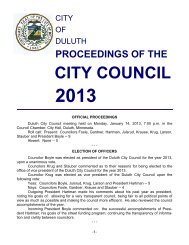Central Entrance - City of Duluth
Central Entrance - City of Duluth
Central Entrance - City of Duluth
Create successful ePaper yourself
Turn your PDF publications into a flip-book with our unique Google optimized e-Paper software.
6.0 Districting Strategy<br />
6.2.1 IMPLICATIONS OF M.H. CORRIDOR PLAN 1979<br />
With regard to the implementation <strong>of</strong> the Miller Hill Corridor Plan, the<br />
document’s concluding sentence states. “As this Plan continues to<br />
achieve results, new horizons and new possibilities for the future <strong>of</strong> the<br />
Miller Hill Corridor Area will be opened up.”<br />
Fast forward 30 years to 2009 and it becomes clear that many <strong>of</strong> the<br />
issues that the Miller Hill Corridor Plan was created to deal with are<br />
still prevalent today as are many <strong>of</strong> the recommendations. In<br />
particular, the issue <strong>of</strong> where and how commercial development<br />
should be located and integrated remains a core focus. The<br />
difference between 1979 and 2009 is that this study incorporates a<br />
layer <strong>of</strong> market‐driven demand into the strategy, which is a critical<br />
component for allocating and locating land uses along the Corridor.<br />
The recommendations for concentration <strong>of</strong> commercial development<br />
around the Miller Hill Mall south <strong>of</strong> Miller Trunk Hwy and infilling <strong>of</strong><br />
land are as valid today as they were 30 years ago.<br />
<strong>Central</strong> <strong>Entrance</strong> continues to face the same challenges, where<br />
congestion, curb cuts, lack <strong>of</strong> sidewalks and safety are seen as major<br />
obstacles for a cohesive neighborhood development. The Miller Hill<br />
Corridor Plan originally viewed <strong>Central</strong> <strong>Entrance</strong> as a neighborhood<br />
scale, but haphazard development led <strong>Central</strong> <strong>Entrance</strong> down a path<br />
<strong>of</strong> highway strip commercial, with no connectivity to the surrounding<br />
residential community.<br />
Wetland sensitivity became an important social issue in the original<br />
Miller Hill Corridor Plan and while developments such as Kohl’s were<br />
approved, this sensitivity should be re‐iterated as it relates to the<br />
impacts <strong>of</strong> commercial development on surrounding land uses,<br />
residential or environmental.<br />
Land Use Allocation & Districting Strategy<br />
73







